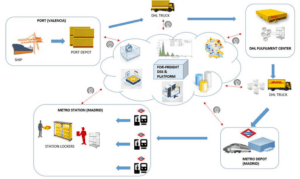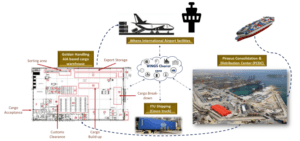Use Cases and Trials
The FOR-FREIGHT platform will support advanced, targeted functionalities in order to serve the demanding requirements of the UCs that will be demonstrated in each trial site facility. These functionalities will be enabled through the combination of existing and newly developed hardware and software components, including the stakeholders’ management systems, vehicles and equipment, as well as personal devices (e.g., smartphones).
The three multimodal UCs that will be set-up demonstrating three multimodal / multi-stakeholders’ solutions of TRL≥ 7 in real-life T&L environments are:
UC1 (Spain)
Blockchain & Digital Twins to support Decision Making Process in multimodal transport combined with a Subway-Based Network for sustainable last mile distribution
The goal of this UC is to aggregate information from all the individual management systems involved in the supply chain process, supporting decision support (DSS) on the use of resources and end-to-end transport planning from ship to port, to central warehouse, to last-mile. In addition, the UC will explore the use of a more efficient, sustainable, faster and safer transport mode in the last mile, focusing on the existing Metro network and avoiding the use of vans/trucks. The platform will enable real-time data exchange through the use of Blockchain and flexible and dynamic transport planning based on Digital Twins and AI/ML predictive analytics, thus leading to reduced emissions and costs for all involved stakeholders.
Two scenarios are foreseen. The first one covers the activities carried out at Valencia Port with the connection to the warehouse, and the second one, the activities carried out from the warehouse to the final customer (last mile distribution).
Facilities:
- (a) Valencia Port
- (b) DHL warehouse
- (c) METRO Depot
- (d) METRO stations.

FOR-FREIGHT Spanish Trial site facility overview
UC2 (Greece)
Port-to-Airport multimodal freight transport: End-to-end optimization with DSS and real-time monitoring & control capabilities
The goal of this UC is to integrate information from the legacy individual management systems of all the involved stakeholders, the field equipment/devices of their personnel, additional information and intelligence provided by newly deployed sensors, devices, ML and data analytics functions. It will support the end-to-end multimodal logistics process by providing logistics operators and end-users the overall real-time and end-to-end picture of the logistics process. Based on the aggregated information and novel intelligence, the FOR-FREIGHT solution will automate processes that are now executed manually, will minimize the room for (human) error, will provide an accurate real-time position of the cargo/container, and will offer full remote monitoring capabilities to logistics operators and users.
Several scenarios will be considered as follows:
- Scenario 1: Container being loaded in Ukraine in Cosco owned/operator ship heading for Piraeus.
- Scenario 2: The information is automatically updated in the FOR-FREIGHT platform, issuing a unique Cargo ID, which is connected to the location, final and intermediate destinations of the container, weight, volume and content identification.
- Scenario 3: Users may monitor the live location, status of the cargo (temp, humidity, vibration, etc.), and realistic Estimated Time of Arrival (ETA) at Piraeus port via the FOR-FREIGHT platform Graphical User Interface.
- Scenario 4: An automated reservation of an air-freight ticket takes place, based on the collaborating airlines, and the realistic time estimated that the cargo will be available at the Athens International Airport (AIA).
- Scenario 5: The DSS systems suggest the exact quantity and timing that appropriate resources should be available at the port terminal (workers, vehicles, cranes), for each of the incoming containers (combining information about the arrival of other vessels and taking into account the entire day’s schedule).
- Scenario 6: The customs authorities are alerted regarding the ETA of the container and are provided with the appropriate documentation to facilitate the clearance process.
- Scenario 7: The DSS systems suggest to the airport cargo handler the exact storage location to be prepared and the number and timing of resources to be available (taking into account other cargo, airline schedule and available resources).
- Scenario 8: The entire process is updated live based on port, road and air traffic data fed directly into the FOR-FREIGHT platform, thus always providing the most accurate ETA possible for all intermediate points (port, customs, airport storage. airplane loading).
Facilities:
- (a) Cosco GR Piraeus Consolidation & Distribution Center (PCDC) – (port of Piraeus, Greece),
- (b) Goldair Handling AIA based cargo warehouse (Athens International Airport, Greece),
- (c) Goldair management system – GoldFreight Warehouse Management System, and
- (d) WINGSChariot Platform for I4.0 & Intelligent Logistics applications.

FOR-FREIGHT Athens (GR) Trial site facility overview
UC3 (Romania)
River port to warehouse hub via railway network - Galati Port
The goal of this UC is to provide functionalities (utilizing state-of-the-art Internet of things (IoT) and data processing solutions (5G, Internet of Containers, etc.) that combines information from all individual management systems (supplier, shipping agent, port authority, terminal operator, warehouse, railway operator, beneficiary) to allow access to fluent and accessible information on transport flow. Also, it will allow prior planning and use of resources throughout the chain. Through the IoT infrastructure, the project consortium will be able to monitor the activities in order to optimize the resources, so as to avoid congestion and reach the operational time target.
Several scenarios will be considered as follows:
- Scenario 1: Automatic ETA update of the ship in the port of Galati, based on historical and real-time tracking data.
- Scenario 2: Full view of the end-to-end process to users, including real-time door-to-door tracking.
- Scenario 3: Suggestions from DSS to the port authorities, the logistics operator and the customs agencies, regarding the necessary resources to be reserved (staff, vehicles, etc.), depending on the size of the goods, the type and the exact ETA.
- Scenario 4: Automatic reservation to railway companies, using a unique cargo ID, based on precise ETA.
- Scenario 5: Notification and advice from DSS to rail freight operators on the required storage space and resources to be available at the exact time of arrival of the goods.
Facilities:
- (a) Barges, pushers, cranes, containers, railway station,
- (b) Platforms:
- (c) VITAL-5G testbed for smart port and,
- (d) OPTIMUM platform for smart logistics and material handling.
